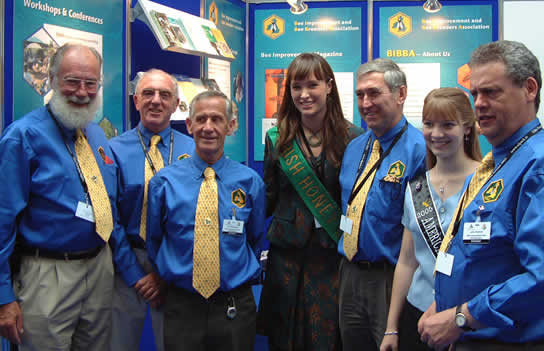 |
The BIBBA Stand and the Irish Honey Queen
at Apimondia 2005 |
EDITORIAL Back
to top
And another Apimondia ends with I suspect the Irish
beekeeping organisations feeling very satisfied with a job well
done. In this issue we report on this bi-annual beekeeping extravaganza
by our intrepid reporter on the spot, Steve Turner, and I hope
that for those who didn’t manage to get there (like me), we can meet
up in Australia in two years time where for a change, as I will
be in the right neck of the woods, I hope to attend. Well done
those who won medals; it’s always a hard task to persuade
judges of the excellence of your product, and to get them to do
so indeed requires a product of supreme excellence. And of course,
commiserations for those who came away empty-handed. The judges
obviously just didn’t understand.
If you were a plant root, would you be able to tell if the root
of another plant was invading your private space? And if you were
a pea in a pod, lying there happily with a bunch of siblings, would
you turn against them once you were planted? We report on this
below. Plants are essential components in the beekeeping world
and for this reason we will keep you up to date on appropriate
plant research, and this in a month when Swiss scientists find
a plant that is as effective in treating hay fever caused by pollen
as conventional treatments but without the side effects. We report
on this as well (see research news). Hay fever, plants, flowers,
pollen, bees; they are all linked and they all demand the thoughtful
attention of thinking beekeepers.
In our increasingly urbanised world, we as beekeepers have a duty
to ensure that the average insect fearing citizen is not terrified
by, or God forbid, actually stung by our little charges (or by
any local wasps, because your bees will still get the blame). If
you want to see the havoc caused by not taking care in this regard,
see how a Dutch beekeeper did it in style in our news section below.
Probably best to try and avoid this sort of situation.
The subject of infant botulism caused by honey has
popped up again with advice from a parenting organisation that
gives the impression that honey is so deadly to infants under one
year that it is surprising that any of them are still alive. Certainly
it is a surprise to myself after reading the leaflet that I survived
my first birthday since evidently my mother fed me copious quantities
of the stuff during my first year, and I don’t think she
was trying to poison me. But there again ….. of course,
reasonable precautions must be taken with all foodstuffs especially
when dealing with very young babies, but in the Fact File this
month, we try and put the botulism/honey affair into some sort
of perspective. If anyone has any new or different facts to share
with us, please write in and let us know. We balance the report
with one from Australia showing how honey can be used as an antibiotic.
GM crops provide us with some news in a report that really says
that if you want to grow them and get them well established in
the UK, you can, and whilst GM companies appear to have suffered
reverses in their fortunes recently, and many have stopped trials,
the reasons for stopping them show that ethical concerns never
came into the decision making process.
Also in this issue, we look at bees as lovers of
fine art (evidently they are and research proves it); new advances
in insecticides; we learn a bit more about our old research friend
the fruit fly; we can follow to our doom another delicious and
calorie laden recipe, and in our historical section, we learn of
early capitalism in beekeeping – and long may it continue.
Our usual regulars continue to educate and delight us with their
articles and also in the articles section we take another look
at propolis in an interesting piece of writing on the subject by
Russian scientists. We also plug on with bee genetics which we
are attempting to keep as simple as possible, mainly so that I
can understand it, and we see in the press section the launch of
a new CD Rom version of IBRAs Bibliography of Commonwealth Apiculture.
This is a welcome addition to our library but on a sadder note,
IBRAs Buzz Extra which carries the news of the CD may not last
as a publication. In fact the editor tells us that this may be
the penultimate edition. Any loss of a quality beekeeping publication
is a loss to us all.
Finally an apology for the lateness of this edition
but we wanted to delay publication so that we could compile the
photographs on Apimondia. So welcome to the ‘late’ August
Issue of Apis-UK and I hope that you have pleasure in reading it.
David
Cramp. Editor.
NEWS Back
to top
SPONSERED RUN FOR BEES ABROAD
Beano Moran, a former beekeeping
student at Hartpury College, Gloucester, is running the Chicago
Marathon on Sunday 9 October. Beano is using the occasion
to raise money for Bees Abroad. He has set himself
a target of £1000 so, if you can, please help
him reach this with your contribution, small or large. Beano
is using the charity-giving website, justgiving, to make
it easy and safe to make a donation. Just go to www.justgiving.com/beano to
find his page and then follow the links to add your donation
to the list. Bees Abroad supports beekeeping
projects in developing countries for the relief of poverty
through beekeeping. For more about Bees Abroad,
please visit our website www.beesabroad.org.uk Many
thanks and Good Luck Beano!
If you prefer not to make donations on line, you
can send a cheque (payable to Bees Abroad UK Ltd) to our
Treasurer: Nick Bishop, The Elms, Painswick Road, Brockworth,
Gloucester GL3 4RP.
DAN DEASY R.I.P.
I have just heard the sad news of the
death of Dan Deasy who passed away peacefully last night.
Regarded by many of us as the father of modern beekeeping
in Ireland, he was also the oldest surviving member of BIBBA
in Ireland. He celebrated his 95th birthday on the first
of April last. Ar dheis lámh
Dé go raibh a anam uasal. Micheál (Quoted
from the BIBBA mailing list).
ONLOOKERS STUNG AT HONEY-MAKING WORKSHOP
Six
people were taken to hospital as bees attacked bystanders
during a honey-making workshop in a residential district
in Breda (Holland) on 29 August.
The bees became aggressive when the bee-keeper was showing
his students how to remove the honey from the honey-combs.
The people attending the workshop were wearing protective
clothing but the bees also turned on other onlookers and
the bee-keeper’s neighbours. Six people were taken
to hospital for treatment for stings. Police intervened when
some of the victims tried to exact revenge on the bee-keeper.
Several officers were also stung. One onlooker described
seeing thousands of bees heading in his direction. He estimated
30-40 people were stung. “Some
people were stung 50 times, others 30 times. I couldn’t
save my son,” he said.
He said he would lodge a police complaint against the bee-keeper
on Monday, claiming it is beyond belief that the bee-keeper,
dressed in protective clothing, worked on the bee hives in
the middle of a residential area. At the request of the police,
the bee-keeper has left the area and has taken his hives
with him.
AN EU-FUNDED PROJECT BEE BREEDING CENTRE TO OPEN
AS PART OF EU-FUNDED PROJECT
A special educational
bee breeding centre has been established as part of an EU-financed
project aimed at preserving the Carniolan bee. The Zelenica
centre is to be home to queen bees of the indigenous Slovenian
type of bee, head of the regional beekeeping association Bostjan
Noc told a press conference on Tuesday, 16 August. The project,
which is to be wrapped up later this month, encompasses the
cooperation of beekeepers from the Slovenian region of Gorenjsko
and the Austrian province of Carinthia. Within the Phare programme,
the EU contributed SIT 12m (EUR 50,087) for the 9-month project,
while the other SIT 3m (EUR 12,521) were contributed by donors
and the Zirovnica municipality, which considers the project
important for preservation of the indigenous species and the
work of legendary beekeeper Anton Jansa.
"The Gorenjsko
region is the home of the Carniolan bee, therefore it is important
for its breeding to continue here," Mayor of Zirovnica
Franc Pfajfar said, adding that the municipality will use beekeepers
to promote Zirovnica as a tourist spot. The beekeepers used
the funds to restore Jansa's amelioration station in Zelenica,
in the Zavrsnica Valley, northern Slovenia. The overhauled
40-year-old station, in which the breeding capacity for queen
bees is to increase from 200 to 1000, will be opened at the
project's official conclusion on 20 August. Purebred queen
bees, priced at EUR 40 each, are to satisfy the needs of Slovenian
beekeepers. However, they also raised a lot of interest abroad,
where they are hard to obtain, according to Noc.
The project also includes an educational seminar attended
by 32 beekeepers and other interested parties. The focus
of the seminar was on practical education of beekeepers in
the Karavanke area. Meanwhile, this year's honey yield is
expected to be the lowest in the past 20 or 30 years due
to the lack of nectar in plants because of abundant rainfall
and the cold summer. Source: Slovene Press Agency
LATEST CURE FOR POLLEN ALLERGY
If its help with hay fever you need, then new help
could be at hand: Butterbur. In a double-blind study of 330
patients, Andreas Schapowal of the Allergy Clinic at Landquart,
Switzerland, and colleagues found Butterbur extract was as
effective as conventional antihistamine, without any of the
unpleasant side effects, such as drowsiness. Over 10 years
Schapowal and his colleagues have bred a special version of
the Butterbur plant, with high concentrations of petasine in
its leaves.

“The extract from the modified plant has a significant
effect in blocking the allergic reaction and is at least
as effective as antihistamine,” says Schapowal. Butterbur
is available in Switzerland and likely to be licensed across
the rest of Europe and the US within two years.
MORE EVIDENCE LINKS HONEY TO HEALING
Australia
Australian researchers have found it is effective
as an antibiotic cream to prevent infections when applied to
catheter sites in kidney dialysis patients. Kidney specialist
David Johnson said honey also had an advantage over the commonly
used antibiotic ointment, mupirocin, in that hospital "superbugs" such
as staphylococcus aureus, commonly known as Golden Staph, had
not developed resistance to it. "There are no documented
cases of honey-resistant bacteria," Professor Johnson
said yesterday.
GM CROPS? GROW THEM IF YOU WANT
There
have been many articles on the rights and wrongs of GM
technology especially that applied to food crops and most
readers opposed to the use of this technology were happy
in the knowledge that even though the situation in the
UK was ‘ambiguous to say the least, growing
Gm crops was at a minimum because of both regulation and
public opinion. It seems however that in placing their
hives in the countryside, beekeepers and their charges
are not as safe as they thought.
In a recent report published in the Guardian
newspaper it appears that GM crops can be grown in the UK
without farmers having to notify the authorities or their
neighbours, the Guardian has discovered after testing a loophole
which allows enthusiasts to grow their own GM maize. Supporters
of GM crops can legally grow them in Britain by applying
to the biotech company Monsanto for a sample pack of GM maize
to test on a British farm.
When the Guardian put this to the test, Monsanto offered
to send a small quantity free provided the farmer sent the
test results and undertook to protect the company’s
interest by not breaching patents, for example, by selling
the seed to a third party.
The government admits there is nothing to stop some GM crops
being grown in the UK. The Department for Environment, Food
and Rural Affairs (Defra) says no regulations exist to prevent
farmers growing GM crops approved for cultivation elsewhere
in the EU because “it seems unlikely that anyone would
want to do so”.
The gap in the regulations which would allow Monsanto maize
to be grown in the UK without notifying Defra arises because
a number of varieties were approved for cultivation in the
EU in 1998, before public concern forced governments to rethink
their policies.
On the subject of GM crops, in an interesting survey carried
out in 2003, the French INRA organisation looked at reasons
why trials of GM crops were halted for one reason or another.
Ethical reasons didn’t appear to come into it. The
graphic below shows the survey results.
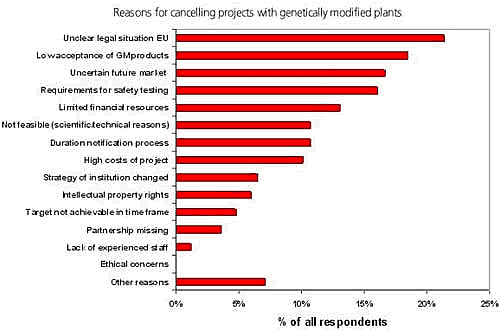
BEE BOYCOTT IN NEW ZEALAND
Imidacloprid rears its ugly head again. The
Poverty bay ‘Flats’ sit on a large silt plain
behind the town of Gisborne on New Zealand North Island. A
large export crop of squashes is grown on these flats and the
reliance on bees for pollination services is vital to the growers,
especially as varroa has effectively killed off feral bee colonies.
But beekeepers are boycotting the squash growing fields despite
the efforts of Bayer Crop Science to persuade them that there
is no link between heavy bee losses and squash crops grown
from seed treated with the systemic chemical imidacloprid.
Beekeepers can walk away from this crop but the mainstay of
the honey season for many beekeepers is the clover crop and
there is an increasing use of the chemical to treat clover
seed. There has been much discussion on the issue with some
saying that as bees started dying in April, and the squash
flowering period ends in February (remember that in New Zealand
the seasons are the wrong way round), it is unlikely that the
cause of bee deaths is due to the chemical. YET, we have all
heard similar arguments in Europe about the safety of the chemical
but France still banned its use on many crops (though many
say this was politically inspired like the BSE/beef ban), and
Spanish beekeepers were panicked into avoiding sunflower crops
using the treated seed.
In the meantime the New Zealand authorities have another fight
on their hands and that is to try and defend the South Island
of the country from the threat of varroa. The rules pertaining
to taking beekeeping items to the South are strict and the
public are well informed on the matter through education and
wide publicity such as the leaflet shown below.
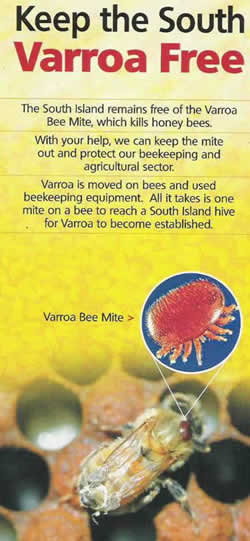
Will it all work? Probably not, but at least it will
delay the problem and give scientists more time to come up
with answers to the problem and any delay will give South
Island beekeepers a few more dollars in their pockets at
the end of the season. Ed.
BEES AS ART CONNOSIEURS
Bees prefer floral paintings - even if they have never
seen flowers before, scientists from the University of London's
Queen Mary believe. Researchers put four paintings - two of
flowers - beneath bees' flight paths, and tracked where they
landed. The bees landed on the two most floral. Van Gogh's
Sunflowers was favourite. The study, made on three colonies raised
in captivity and which had never seen flowers, was reported in
the journal Optics and Laser Technology. These features are recognised
by bees that have never been exposed to flowers before said Professor
Lars Chittka.
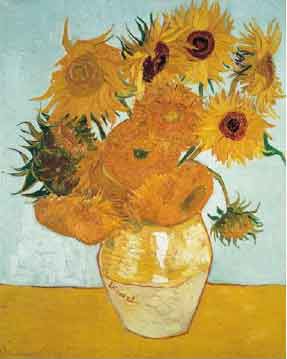
About 11% of approaches to the flower paintings ended with
a landing, compared to just 4% with the other paintings, the
study found. As well as Sunflowers, the team showed the bees
Paul Gauguin's A Vase of Flowers, Patrick Caulfield's Pottery,
and Fernand Leger's Still Life with a Beer Mug. The bees flew
towards the Van Gogh picture 146 times and landed on it 15
times. A Vase of Flowers produced 81 approaches and 11 landings.
Caulfield's Pottery produced 138 approaches but only four landings.
And Still Life with a Beer Mug attracted bees on 117 occasions,
but again only four landings.
Professor Lars Chittka said: "The results show that the
flower paintings have captured the essence of floral features
from a bee's point of view, and that these features are recognised
by bees that have never been exposed to flowers before. "Flowers
contain all the goods that a bee needs to thrive - pollen and
nectar - and selection has therefore favoured bees with 'aesthetic
preferences' for those flowers which offer the best bonanzas."
A
bee's favourite colour is blue, he added, which is associated
with high-nectar flowers. This could be why the bees were strongly
drawn to the blue "Vincent" signature
in Van Gogh's painting, as well as the blue blooms in A Vase
of Flowers, and a light blue square in Still Life with a Beer
Mug.
RESEARCH
NEWS Back
to top
FOUR POPULATIONS OF APIS MELLIFERA MELLIFERA L. IN
URALS
Ilyasov R.A.
Apis mellifera mellifera L. is a very interesting honey bee.
Its high cold endurance and high capacity for work had made
it indispensable for northern beekeeping in the Urals. The climate
of the the Urals is very inhospitable with long winters and
short summers. The bees of the Urals are therefore special
dark European bees adapted to the region. Unfortunately, many
areas were hybridizated by Apis mellifera caucasica.
In the biochemistry and insect adaptability laboratory we
carry out research into these autochtonous honey bees. We use
different methods for the identification of the dark european
bee population. We found in the Bashkortostan republic and the
Perm oblast (Russia, South and Middle Urals) four unique not
hybridizated populations of Apis mellifera mellifera by morphometrical,
molecular methods. We investigated by PCR analysis of the intergenic
region COI-COII; microsatellite locii 4A110, Ap243, Ap049; the
locus of gene antibacterial peptide defensin; locus of 2 subunit
NADH dehydrogenase (ND2). We sent sequences of the ND2 gene
to GenBank. Future plans include identification of new dark
european honey bees in other regions of Russia.
Our investigations will also help to restore the native gene
pool of Apis mellifera mellifera L. in the hybridizated regions.
We would be glad to collaborate with other European bee researchers
and beekeepers. We think, all subspecies of bees must live separately
and must not be hybridized. We must save unique dark European
honey bee. Our Address for contact: Institute
of Biochemistry and Genetics. Ufa Scientific Centre of Russian
Academy of Sciences. Russia, Bashkortostan, 450054, Prospekt
Oktyabrya, 71. Laboratory of Ph.D. A. G. Nikolenko. E-mail:
apismell@hotmail.com
Bees and beekeepers depend on plants and flowers and
the more we know about these fascinating forms of life the
more knowledgeable we become in our craft. This piece of research
news shows that plants have many stratagems for self defence
and survival including having a good idea of who’s who
in the area. Ed.
NEWER, SAFER MORE POTENT INSECTICIDES
Insecticides
and advances in insecticide science are of vital importance
to beekeepers and we should all have an idea of what is going
on in this critical area of our lives. Here is some research
news of the development of so called safer yet more potent
insecticides.
Bayer Crop Science and DuPont have developed two new classes
of broad spectrum insecticides that show promise as a safer
and more effective way to fight pest insects that damage food
crops. The insecticides, which represent the first synthetic
compounds designed to activate a novel insecticide target called
the
Many of the most widely used insecticides today act on only
a handful of exploited targets, including the organophosphates,
which block acetylcholinesterase, an enzyme that helps control
nerve activity. Some experts are concerned that these older,
less-selective insecticides could pose heath risks and there’s
a growing effort underway to find safer replacements. Targeting
the ryanodine receptor may offer a promising alternative, researchers
say. Ryanodine, a natural alkaloid discovered years ago in a
species of tropical plant, has been used to study muscle physiology
in a wide variety of organisms, including insects and mammals.
Ryanodine receptors regulate muscle and nerve activities by
modifying levels of internal calcium in these cells. These receptors
exist in both mammals and insects but have distinct differences.
Researchers have known that ryanodine itself has insecticidal
properties, but no synthetic molecules had previously been identified
that potently and selectively target these receptors in insects,
until now.
Nihon Nohyaku Co., Ltd., based in Japan, and Bayer CropScience
AG in Germany have jointly developed Flubendiamide, the first
example of the phthalic acid diamides, a novel class of insecticides
that activate the ryanodine receptor. The insecticide is highly
effective against many different species of caterpillars, says
Masanori Tohnishi, a senior research scientist at Nihon Nohyaku.
In early tests, the compound showed high activity against the
tobacco budworm (Heliothis virescens), which is known to cause
serious damage to cotton, tobacco and other crops, the researchers
say. The compound did not have any measurable effect on mammalian
ryanodine receptors, according to Peter Lümmen, Ph.D.,
a research scientist at Bayer CropScience.
DuPont, based in Wilmington, Del., is developing another group
of compounds that target the ryanodine receptor. Called anthranilic
diamides, these novel compounds show excellent control of pest
insects with exceptional mammalian safety, according to the
researchers. They were the first to demonstrate the mode of
action of these ryanodine receptor-active molecules, says Daniel
Cordova, a researcher at DuPont Crop Protection.
Both classes of compounds are believed to have high potency,
the researchers say, although they are structurally different.
Both insecticides are still in developmental stages. The research
team at DuPont says they have cloned ryanodine receptors from
several insect species and that these receptors may help provide
a better understanding of their role in calcium signaling, which
could lead to new insights into human diseases.
(This story has been adapted from a news release issued by
American Chemical Society)
SUPERFLY
Resistance to chemical insecticides is
a problem faced by all bee keepers especially in our fight against
varroa. The use of chemicals generally is of vital interest
to us all whether they are for the protection of our bees or
whether they cause massive bee losses, and we are all aware
of the problems that may arise in their use. This has now been
exemplified by the discovery by scientists of a ‘superfly’ which
defies current understanding of how resistance to drugs and
pesticides can spread. And yet again it is our old friend the
fruit fly, that most experimented on of animals. Scientists
suggest that the genetic factors that enable some insects to
withstand insecticides such as DDT may be the same as those
that are hampering attempts to control the hospital superbugs.
They found for instance that DDT resistance in fruit flies confers
an advantage when inherited through the female, ie by becoming
DDT resistant the female flies are passing on some unknown advantage
to their progeny.
WHO NEEDS BEES?
Scientists at Annamalai University
in Tamil Nadu have produced artificial honey in laboratory by
mimicking the process that takes place inside honeybees.
As most beekeepers know, honey is composed of around 80 per
cent sugars (fructose and glucose) and 20 per cent water and
the sweetness is mainly due to the presence of fructose. The
bees produce honey by vigorously mixing the nectar collected
from flowers with their saliva. In this process, enzymes from
yeast cells in the salivary glands help to increase the level
of fructose in nectar turning it to sweet honey.
K Kathiresan and K Srinivasan at the university's Marine Biology
Centre in Parangipettai have recreated this process in laboratory.
They have produced honey-like substance by inoculating yeast
cells isolated from the bee salivary glands into a flask containing
a solution of ordinary sugar (sucrose). Their experiment showed "a
substantial increase in the level of fructose within 24 to 72
hours."
"The present experiment shows that the yeast cells convert
sugar (sucrose) solution onto honey-like solution," they
reported in the Indian Journal of Experimental Biology. In terms
of fructose, glucose, free amino acids and pH value (which is
a measure of acidic or basic nature of the solution) the artificial
honey is very similar to the natural honey, they reported.
According to them, honey can therefore be produced artificially
using yeast cells and "there is great scope for developing
this honey making as an industrial venture."
We are in the process of using yeast (a strain of
bakers yeast) to invert sugar for feeding to bees. Invert
sugar has many advantages when used for feeding bees and this
enzymatic conversion process is much safer, more controllable
and generally more successful than acid hydrolysis used by
many beekeepers. I believe that there are several methods
for detecting ‘honey’ manufactured in the above
article and few could agree that it is a threat to beekeepers
and their product. Interesting though. Ed
PLANTS DISCRIMINATE BETWEEN SELF AND NON SELF
How does a root recognise another root?
Two peas in a pod may not be so friendly when planted in the
ground and even two parts of the same plant, once separated
may treat the former conjoined twin as an alien "enemy," according
to a Penn State researcher.
"We were looking at how plants determine who is a competitor
when competing with other roots for limited resources," says
Dr. Omer Falik, postdoctoral researcher in plant ecology. "There
is no reason for roots to fight if they belong to the same plant."
The question was, do plants recognize their own roots and avoid
competing with them and how do they do this? Working with common
garden peas, Falik worked with Dr. Ariel Novoplansky at Ben
Gurion University of the Negev, Israel. The researchers used
plants that had two roots and planted them in a chamber that
forced them to grow a specified distance from each other and
from roots of a neighbouring plant.
"We found that the roots grew significantly more and longer
secondary roots on the non-self side," Falik told attendees
at the 90th Annual Meeting of the Ecological Society of America
today (Aug 8) in Montreal, Canada.
The mechanism for this self/non-self discrimination could be
based on either individually specific chemical recognition --
such as that known from plant reproductive systems -- or physiological
coordination between roots that belong to the same plant. To
test this, the researchers used plants that had two roots and
two shoots and split them into two separate plants that were
genetically identical, but physiologically separated. The plants
acted as if their separated twin was a non-self plant, even
though genetically it was identical. "This eliminated the
possibility that the mechanism was based on specific chemical
recognition," says Falik. "The results prove that
at least in the studied plants, self/non-self root discrimination
is based on physiological coordination between roots belonging
to the same plant. Such coordination might be based on internal
pulsing of hormonal or electrical signals which desynchronize
when the plants are separated."
THE
BEE PRESS Back to top
BUZZ EXTRA AUGUST 2005
No Need To Reinvent The Wheel. The latest edition
of Buzz Extra brings us news of the launch of a CD-ROM version of
the update of IBRAs Bibliography of Commonwealth Apiculture. When
the first edition came out some quarter of a century ago, the bibliography
has grown and the new volume covers more specifically the countries
of the Commonwealth rather than concentrating on the third world
countries and now includes Australia, Canada, New Zealand and of
course the UK. The information should form a vital resource for
beekeepers, farmers, agriculturalists, agronomists, foresters and
a host of others involved in land management and conservation. Once
read, it could save much reinventing of the wheel. http://www.ibra.org.uk
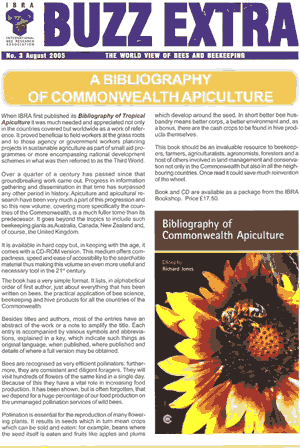
BEECRAFT
Beecraft August 2005 Volume 87 Number 8
Claire Waring Editor. www.bee-craft.com
Beecraft Subscriptions http://www.bee-craft.com/shop/
Contents: Defra’s proposed
bee health cuts; Bee medicines: put pen to paper; Queen mating
problems Roger Pattenson; Apiguard questions and answers Seb Owen;
Other bees: mining bees Neil A Robinson; Variations: part 2 Celia
Davis, NDB; A year in the apiary: robbing and wintering David Aston,
PhD, NDB; Your FREE Gift; The Bee Craft Photo Competition; From
the Lab: a collective raincoat Adam Hart, PhD; Moving to France:
part 2 Max Westby; In the Apiary: having fun with bees (part 15)
Karl Showler; Book and DVD reviews: Sweetness and Light, Hattie
Ellis, Traditional Irish Honey Recipes, Brigid Barrett, The Monk
and the Honeybee (DVD), Field Guide to the Bumblebees of Great
Britain and Ireland, Mike Edwards and Martin Jenner, The Complete
and Easy Guide to Beekeeping, Kim Flottum, Honey: A modern wound
management product, Richard White, Rose Cooper and Peter Molan,
Bees Besieged, Bill Mares; The ‘B’ Kids; Around
the colony; Classified advertisements; Calendar.
Editorial: On Monday 11 July, the BBC Today programme
invited anyone who wanted to be a reporter for a day at the
Yorkshire Show to contact them. I am sure that many stories
were received, but the one they chose was BBKA’s concerns about Defra’s proposed
cuts to the Bee Health programme, submitted by Michael Badger. Lord
Bach, the new Minister for Sustainable Farming and Food, was also
interviewed on the Today programme (see page 5). He stated that if
the shook swarm method for European Foul Brood (EFB) control was
shown not to be effective, there will be no cuts in the Bee Health
budget. I know that some of you will, unfortunately, have found EFB
in your colonies this year. Anyone making a claim through Bee Diseases
Insurance will be included in their statistics. However, if you have
not made such a claim, please let me know how many of your colonies
were treated by shook swarming and how many were destroyed on the
advice of your Seasonal Bee Inspector. I would also be very interested
to hear of your experiences following use of the shook swarm technique.
Did it work? Did the colony build up as expected afterwards? Did
EFB recur in the following or subsequent years? We need factual reports
of your practical experience of this technique and we need information
from as wide an area as possible. Only you know what has happened
in your apiary. Please share it with us. All subscribers will find
the second free Bee Craft Apiary Guide with this issue (see page
29). This covers American Foul Brood (AFB). A new set of five Apiary
Guides on Integrated Pest Management is also available – see
page 30 to order your set. Claire
Waring
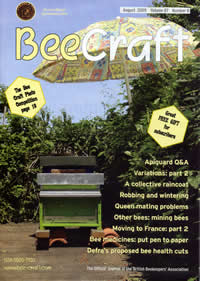 |
NEW BOOK Back to top
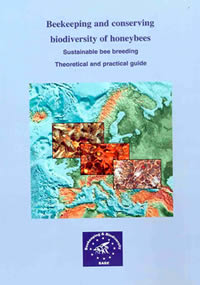
Beekeeping and conserving biodiversity of honeybees
Sustainable bee breeding and theoretical and practical guide.
180 pages A5. ISBN:
1-904846-14-9. This is a new title reporting the work of
6 bee labs in Europe who have participated in the BABE (Beekeeping
and Apis Biodiversity in Europe) project. The lead lab is that of
Dr Robin Moritz in Germany and there are contributions from: Jean-Marie
Cornuet, France; Cecilia Costa, Italy; Pilar De la Rua, Spain; Stefan
Fuchs, Germany; Annette Bruun Jenson, Denmark; Marco Lodesani, Italy;
Robin Moritz, Germany; Bo Vest Pederson, Denmark; Jose Serrano, Spain
Michel Solignac, France. As such it is a very important
contribution to the literature in this area. £11.00
UKPP. Available from Northern
Bee Books online URL: http://www.beedata.com/nbb/babe.htm
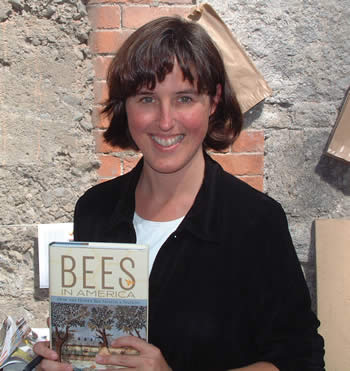
Bees in America - How the honey bees shaped a nation by
Tammy Horn "Horn
shows how beekeeping and honey have influenced so much of our U.S. history
and culture. American beekeepers will be grateful that Horn is sharing the
story of their love affair with the honey bee to the general population. Bees
in America is a welcome respite from our fast-paced, technology-driven society." Joe
Graham Editor American Bee Journal £23.50 UKPP.
Available from Northern Bee Books online URL: http://www.beedata.com/nbb/horn.htm Photograph
by ST Tammy Horn on the Northern Bee Books stand at Apimondia 2005.
ARTICLES Back
to top
Bees and Gravitomagnetism (Part 2 of 4)
Ian Rumsey
A method of possibly influencing gravitomagnetism, and in consequence the
East-West comb alignment, could be by the introduction of a vertical magnetic
field.
A magnet from a loudspeaker is a circular disc with a hole in the middle
with one surface being a north pole and the other south. When laid flat on
top of the inner hive it provides a strong vertical field as shown in (fig
1) The green horizontal lines represent the Earth's magnetic field prior to
the introduction of the magnet and the red lines the resultant field of their
combined effect. To enable a scale of magnetic influence to be obtained the
green lines have been plotted 6 inches apart.
This diagram represents vertical magnetic fields crudely measured with the
aid of a simple compass.
 |
 |
| fig 1 |
fig 2 |
The second diagram (fig 2) has been similarly constructed to the same
scale but represents the resultant horizontal fields 7 inches below the roof
of the inner hive. In both cases the distortion of the magnet's field by the
Earth's magnetic field, would appear to be quite overpowering.
Let us introduce into the inner hive a swarm, place the magnet on the roof
inscribed with the compass bearings N,S,E,& W, and position the outer hive,
(numbered 6-4) over the top.
Photos below refer.
We must now show patience and allow time to pass.
Bee Propolis: A real Alternative
For well over a century modern science has progressed at a startling rate.
With this increase in knowledge has come medicinal and healthcare benefits
that have seen ages peak and diseases eradicated. These medical advances were
based around the paradigm of the “magic bullet”, isolating the
active ingredient and using it to alter the chemistry of a single molecule/protein
to elicit a change of state in the patient.
Success however has turned to obsession as cracks appear in the armoury of
disease fighting drugs at our disposal. MRSA is rifling through our hospitals
as antibiotics become ineffective and severe side effects of modern drugs are
becoming common place now years after their introduction. A direct consequence
of a one dimensional strategy, it is maybe the time to acknowledge the synergistic
health benefits of natural medicine.
Propolis is a unique natural medicine because of its breadth of action. It
has antibacterial, antiviral, antifungal, anti-inflammatory, anti-cancer and
immunomodulatory effects, it could help treat asthma, allergies, arthritis
and joint disorders, eczema and dermatitis, ME, viral infections including
HIV and even cancer. This medicine could help treat an illness or keep you
fit and healthy.
Propolis: Defender of the City
Propolis is a mainly
resinous substance that bees collect from trees and plants. Being made up of
waxes, resins, fatty acids and even amino acids. Aristotle reputedly coined
the name Propolis meaning “defender of the city”.
This is exactly what Propolis is for the hive, it acts as a bee population’s
external immune system keeping the hive sterile and free of microbial invaders
Evidence Based Medicine
In the following paragraphs
I will describe to you the pharmacological properties of Propolis. Before I
do so I must explain where this evidence comes from. All the properties and
actions of Propolis have been witnessed and detailed in scientific studies
which have subsequently been published in journals. The bulk of these scientific
studies have been performed in vitro (i.e. in a test tube) or in vivo (i.e.
in a host animal for example rats), a much smaller proportion of these studies
are clinical trials tested on humans. The abstracts of these papers can be
found on the Medline and pubmed databases on the Internet.
Propolis: A natural antibiotic
Propolis is probably
best known for its antibiotic properties. Even as early as 1960 French(1)
research demonstrated the bacteriostatic action on Bacillus subtilis, Proteus
vulgaris and Bacillus alvei. The results have been replicated many times and
Propolis has even been shown to be effective to MRSA(2), the same antibiotic
resistant bacteria that has infected up to 70% of our hospitals. A 1997 study
by Calder et al. at the University of Oxford concurred with these results and
found that the cinnaminic acids and flavanoids present in Propolis in particular
show bacteriocidal action. This action believed to be as a consequence of Propolis
uncoupling the bacterial energy respiratory chain. Interestingly this action
may be involved in a synergistic action with antibiotics when used together,
boosting the effectiveness of the drugs.
Anti-Viral and immuno-stimulatory
Viruses present
a unique dilemma in the quest for good health, they are not affected by antibiotics
and mutate so frequently that vaccines are hard to produce. They also cause
illness by hijacking cells and using the cells machinery to replicate. Modern
drugs aim to slow or stop the virus from the replicating and subsequently because
they are attacking host cell machinery they have certain side effects. Viruses
perhaps pose the greatest threat to humans’ health,
we are currently in the middle of a HIV pandemic with “39.4 million” people
infected world wide. With a Flu pandemic overdue and certainly on its way and
predictions of world wide casualties and chaos, a solution is needed.
The bioflavanoids in propolis have a unique approach to combating Viruses,
instead of trying to combat them once they have infected a cell, they lock
the virus in its protein coat. This means that the dangerous machinery and
DNA/RNA of the virus is nullified and the infection stopped.
Propolis has been shown to be more effective than the pharmaceutical anti-viral
acyclovir in treating genital Herpes in a clinical trial conducted in the Ukraine(4)
and there is growing evidence that Propolis could help treat people with HIV(5).
Propolis also works hard as an immunomodulator which is of interest for all
of us. It does this by altering the way cytokine production and release is
managed. Cytokines are the chemical messengers that allow immune system cells
to communicate. By altering the cytokine system, it primes the immune system
to be ready to react to antigens quickly and effectively.
As well as this, bioflavanoids within Propolis stimulate the production of
interferon which can help people recover from ME, stimulating their immune
system. This alteration of the cytokine and interferon systems means that your
body is ready to fight off infection and keep you healthy, making a case for
using propolis as a supplement for good health, like vitamins. Prevention is
better than the cure.
Anti-inflammatory and anti-allergen
A survey of
Propolis consumers showed that arthritis was the health problem that Propolis
was used to treat the most. This is because of the potent anti-inflammatory
properties of the propolis constituents in particular CAPE (Caffeic acid Phenyl
ester), CAPE has been shown to suppress T cell activation. A paper by Marquez
et al in 2004(6) evaluated this to mean that since T-cells play a key role
in the onset of several inflammatory diseases, CAPE is important because the
this phenolic compound is a potent inhibitor of early and late events in T-cell
receptor-mediated T-cell activation. Results like this have led other researchers
to propose that CAPE is a worthwhile agent for reducing the severity of conditions
associated with inflammation.
Many of the experiments performed on CAPE were done so in vitro, however
the anti-inflammatory properties of Propolis have been documented in rats when
treating rat adjuvant arthritis. A paper by Park et al in 1999(7) concluding
that the ethanolic extract of propolis had profound anti-inflammatory effects
on both chronic and acute arthritic inflammations.
These anti-inflammation properties extend to other illness and disorders
such as asthma and allergies reducing both smooth muscle airway contraction(8)
and allergic responses. Any disorder or illness related to inflammation could
be helped by Propolis.
Anti-tumour/cancer
Propolis and CAPE have been shown
to reduce the size of tumours and to selectively destroy and to curb the proliferation
of malignant cells of many different types of cancer. As recently as June 10th
2005 Cancer researchers have been given a grant of a million dollars to investigate
the therapeutic value of Propolis for cancer. Costas Koumenis the lead investigator
for the study was quoted as saying, “ a very interesting property of
these compounds is that they have been shown to cause cell death in tumor cells
but not in normal cells." This study along with other current studies
promises to propel Propolis into the limelight in the field of cancer treatment.
Current Propolis Research in the UK
BVR
(BeeVital Research) recently won a major government Research and Development
Award, part of a £250,000 research programme looking at the chemical,
biological and clinical properties of propolis.
These studies will focus on the:
- Documenting the regional variances in chemical and biological properties,
by HPLS, GC-MS and NMR. (Taking place at Univeristy of Strathclyde)
- Futher investigating the role of Propolis in the Hive (University of
Gloucester)
- Dental trials – looking at effectiveness of Propolis for Mouth Ulcers,
Pericorinitis, Gingivitis and Sensitive Teeth. (Manchester University Dental
school)
- HIV/AIDS trials – looking at the effectiveness of Propolis with
anti-virals in Zambia and Tanzania
- The effects of standardised propolis on mood, stress, fatigue and cognition
at the Human Cognitive Neuroscience Unit at University of Newcastle.
- To evaluate the use of local and non – local propolis for wound
healing and the treatment of skin and other dermatological problems. (The
Regional Teaching Hospital for University of Dar es Salaam)
How to use/find propolis products?
A large range
of propolis products are available on the market ranging from tablets, capsules,
tinctures and liquids to specialist products for skin care – soap,
lip balm, creams and oral health care – toothpaste, mouthwash, lozenges
and tooth and gum liquid.
Traditionally these have been available through health food stores but are
increasingly available in independent pharmacies.
Choosing the best products is not always easy. Current regulations means
manufacturers cannot make any kind of medical claim for products that have
not been licensed as medicines despite the fact that there is a sound evidence
basis for such claims. Part of the reason for this is that no single body is
responsible for ensuring that product offered for sale actually are what they
say they are.
For this reason the BVR (BeeVital Research) programme is targeted at developing
full medicines licenses for some key products. In the meantime BVR have formulated
a number of products for the health food market based on their research. Consumers,
when purchasing products should look for those products produced by companies
who can back up their products by good manufacturing practice (pharmaceutical
standard manufacturing) and research.
References:
(1)Lavie, P. (1960). Annals Abeille, 3: 103-201
(2)Anti-Bacterial properties of propolis. Grange, J. M., Davey, R. W.
Journal of the Royal Society of Medicine, 83: 160-1 (1990)
(3)Anti-microbial action of propolis and some of its components:
The effect on growth membrane potential and motility of bacteria. Mirzoeva,
O. K., Grishanin, r. n., Calder, p. c. microbial – res, 152: 239-246
(1997)
(4)A comparative multi-centre study of the efficacy of propolis,
acyclovir and placebo in the treatment of genital herpes (HSV).Vynograd,
N.; Vynograd, I. ; Sosnowski, Z. Institute of Epidemiology , Lvov State Medical University , Lvov , Ukraine .
Phytomedicine (2000), 7(1), 1-6. CODEN: PYTOEY ISSN: 0944-7113.
(5) Current lead natural products for the chemotherapy of human immunodeficiency
virus (HIV) infection. De Clercq, Erik. Rega Institute
for Medical Research, Katholieke Universiteit Leuven , Louvain , Belg. Medicinal
Research Reviews (2000), 20(5), 323-349. CODEN: MRREDD ISSN: 0198-6325
(6) Caffeic acid phenethyl ester inhibits T-cell
activation by targeting both nuclear factor of activated T-cells and NF- k B
transcription factors. Marquez, Nieves; Sancho,
Rocio; Macho, Antonio; Calzado, Marco A.; Fiebich, Bernd L.; Munoz, Eduardo.
Departamento de Biologia Celular, Fisiologia e Inmunologia, Universidad de
Cordoba, Facultad de Medicina, Cordoba, Spain . Journal of Pharmacology
and Experimental Therapeutics (2004), 308(3), 993-1001. CODEN: JPETAB ISSN:
0022-3565.
(7) Suppressive effects of propolis in rat adjuvant arthritis. Park,
Eun-Hee; Kahng, Ja-Hoon. College of Pharmacy , Sookmyung Women's University,
Seoul , S. Korea. Archives of Pharmacal Research (1999), 22(6), 554-558. CODEN:
APHRDQ ISSN: 0253-6269.
(8) Bulgarian propolis induces analgesic and anti-inflammatory effects
in mice and inhibits in vitro contraction of airway smooth muscle. Paulino,
Niraldo; Dantas, Andreia Pires; Bankova, Vassya; Longhi, Daniela Taggliari;
Scremin, Amarilis; Lisboa de Castro, Solange; Calixto, Joao Batista. Grupo
de Pesquisa e Desenvolvimento de Biofarmacos (BIOFAR), Universidade do Sul
de Santa Catarina, Tubarao , Brazil . Journal of Pharmacological Sciences
( Tokyo , Japan ) (2003), 93(3), 307-313. CODEN: JPSTGJ ISSN: 1347-8613.
About the author: James Fearnley of BeeVital Research is one of
the worlds leading authorities on Propolis He has written extensively on the
subject and published a major review of all the current research up to 2001
- Bee Propolis – Natural
Healing form the Hive Souvenir Press. http://www.beevitalpropolis.com
Clearing the decks
George Bernard Shaw (a beekeeper) must have had me
in mind when he said - "A life spent in making mistakes is not only
more honourable but more useful than a life spent doing nothing." (GBS,
1856-1950.)
I am sure I am not the only one who puts clearer boards on their hives and
doesn’t get back to them for several weeks. As you would expect, it usually
means that the bees have learnt to bypass the escapes and there are a fair
number of bees back in the supers. That is just a nuisance that can be solved
by moving the supers some distance away and vigorously smoking each in turn
to drive out the last of the bees.
I used New Zealand/Canadian clearer boards on some of my hives. Those are
the ones with either four or five holes capped off with a wire “gate” or
plastic cones. The received wisdom is that these clear the bees quicker than
Porter escapes. All very well unless it takes you three weeks to get back to
them. By that time the bees are almost certain to have worked their way back
into the supers. I had a different problem. The problem I had was that on one
or two of them the high sides created quite a deep space between the actual
board and the brood box.
On one clearer board in particular, the bees had filled the entire space
(about 17-18 inches square) with brace comb absolutely crammed with the darkest
honey I have ever seen. There were also about two or three thousand bees in
the “lid.”
I toyed with the idea of leaving this board on top of the brood box in the
vain hope that the bees might take it down but in the end I decided to try
to harvest the honey. With a combination of brushing and smoking I did get
most of the bees out and cut the brace comb into a spare bucket. When I got
it home I literally crushed it over a sieve and collected 10lb of almost black
honey. I don’t intend to repeat the mistake of leaving the clearer boards
on too long but it was a useful bonus in that case. Incidentally the rest of
the hive yielded 108lb of extremely light coloured honey!
Now that Autumn is here and the honey is coming off the hives, the hard work
is beginning and hopefully the honey-money should start rolling in. If you
give your wet supers back to the bees to clear out it will probably take a
week or two before you can lift them off again to store. Last winter I put
four mothballs in each super and wrapped it in a black plastic bag sealed with
parcel tape. That kept the wax moth away and it was a cheap solution; if it
appeals to you – try it.
After the supers are cleaned and in any case as soon as possible, in go the
Varroa strips or Apiguard. I have decided to alternate the two, so this year
will be Apiguard. The feeders full of sugar syrup will need go onto the hives
too. The gurus say feeding should be completed by the end of September, though
with the milder autumns recently I am not too fussed if I am still feeding
a few weeks later. In any case I also adopt the Peter Springall practice of
feeding each hive with fondant on Boxing Day.
Once you have all that delicious honey safely bottled you will need to decide
which room in the house to fill with it – as long as She Who Must Be
Obeyed lets you get away with it. I find that it is psychologically stimulating
to build a huge skyscraper in the sitting room – directly in front of
the television set. That way I have to get marketing before I can watch “Spooks.” A
tip from Steven Turner – if you are storing your jars of honey where
it might get damp; fit the jars with plastic caps (they can be recycled a good
few times) and only put metal caps on when you “send them to market.”
It is not too early to start planning for next year. The start of my year
is the beginning of November when I begin to renovate and clean supers, constructing
floors and crown boards (I stopped buying them when I found out how easy/cheap
it was to make them myself), making up frames, cleaning queen excluders (carefully)
- checking that the space between wires/slots has not become enlarged.
A quick story before I leave you. My beekeeping friend, the one I have told
you about before, who would be out of his depth in a puddle– of whom
his wife once said – “ you’ll have to knock on his head to
see if he is at home, ” asked me to help him move a hive from a friend’s
garden to his house – a distance of about 6 miles.
When I reached the friend’s house I found that, impatient as ever,
he had already got the hive into his car – also….the
bees. The interior was so dense with bees that if they had beaten their wings
slightly faster they could have lifted the car with them. Travelling screen?
Wassat?
“What do I do now?” he said.
“Retire from beekeeping?” I suggested.
Fully clothed against the horde, I carried the hive back into the garden,
left the doors of his car wide open on his friend’s driveway and gave
him a lift home. The following day when we returned the bees had gone back
to the hive in the garden but a fox had got into his car during the night,
ripped up the upholstery and crapped on it whilst cleaning up the spilt honey.
And the moral to that story is - The keeping of bees is like the direction
of sunbeams. (Henry David Thoreau) Mike Oliver

Build Your Own Wasp Trap
I had a massive attack of wasps last year - to the effect that they
actually robbed out a weak hive before I realised what was going on. I tried
a variety of wasp trap designs before arriving at the one I use now. It takes
5 minutes to make each trap and I have caught several hundred wasps a day using
this design. It's based on the principle that wasps are attracted into the trap
by smell of sugary fruit juice and alcohol (wine dregs and ribena work well).
Once inside the trap wasps fly upwards towards the light - which is their
weak point.
Materials
1 two litre plastic milk container or pet coke/ fanta/ juice bottle.
1 roll of black (or light proof) duct tape.
1 Sharp stanley knife.
cover the bottom half of the milk container/ bottle in black
duct tape.
Cut Through the duct tape and the plastic bottle to make
Letter Box type hinged flaps - on three sides of the bottle. Important -
do not cut off the flap to make an open slot. Leave the flap attached at
the bottom so you can push it in slightly. Size of slot - experiment - I
find about 5 cm long by 1 cm high works well. The flap should be slightly
springy - so wasps can push their way in.
Safety Note: Cutting through a shiny pet bottle can be
dangerous if knife slips - takes a lot of pressure and control. Be sure to
tape the bottle first - tape gives the knife more grip and stability. Do
not cut on your lap - use a table and cut away from your body.
Pierce top area of bottle and sides above the slots with a sharp point - a
dart is perfect - to allow scent of juice to drift out. Make fifty or so small
holes near top.
Fill bottom third of bottle (in the darkness) with sticky fruit juice, coca
cola, old wine, sugar syrup, bit of vinegar etc.
How It Works
Wasps smell the fruity juice through small holes or hinged flaps.
They enter via the hinged letter box flaps and try to get juice.
They are surrounded by darkness except above, so fly upwards repeatedly.
Eventually they fly into the liquid and drown.
This is so effective that you must clear the bottles every few days or the
mass of wasp bodies stops wasps drowning. Throw dead wasps on compost heap.
Remember this only works well if you cover the bottom half of bottle with black
duct tape (or other opaque tape) and cut your slots so that they make a hinged
flap. I made 6 or more traps in about 45 minutes - placed one near each of
my hives. Caught literally thousands of wasps in a single week.
For the full article
and colour photographs visit the URL: http://www.dartingtonhive.co.uk/wasptrap.html
Graham
White
Genetics - Part Two Despite
the fairly complicated family structure of a colony outlined in part one (Apis
UK July 05), and the fact that a male bee emerges from an unfertilised egg,
the basic principles of genetics still apply to bees, and now we go beyond
generalities and plunge into chromosomes, genes and alleles. We know that
queens and workers hatch from eggs containing two sets of chromosomes, one
set of 16 from each parent (diploid), and that drones hatch from eggs containing
one set of chromosomes (haploid). This latter process of drones hatching from
unfertilised eggs is termed parthenogenesis.
The chromosomes contain hereditary units called genes. The specific place
on a chromosome where particular genes are found is called a locus. On rare
occasions a gene entering an egg or sperm has changed or mutated and will
have a different effect than the original gene. All the forms of a gene that
occur at a locus are called alleles. Allele is just a word that means a version
of a gene. For example, genes for blue eyes and brown eyes are alleles (or
different versions) of the eye colour gene. There is a gene that controls
the sex of a bee and is of course called the sex allele. If there are two
different sex alleles present, the bee will develop into a female (worker
or queen). If there is one allele present, the bee will develop into a drone.
There are two ways that only one sex allele could be present. Firstly as we
have explained, the egg may be unfertilised and so will only contain one sex
allele anyway; and secondly, both the mother and the father may contribute
the same allele in a fertilised egg and this egg even though fertilised will
also develop into a drone. The drone will then have two sets of chromosomes
instead of the normal one (i.e. a diploid drone) and will not be able to function
as a normal drone. These diploid drones are always destroyed by workers who
eat them on hatching from the egg in the cell. When therefore inbreeding occurs
and it is more likely that mother and father will have the same allele, the
queen will lay eggs in worker cells that are in fact diploid drones. These
will be eaten and so the brood pattern will be full of holes alternating with
normal larvae. We’ve all seen it. So the closer the relationship between
mating partners, the fewer the viable brood. A brother/sister mating will
produce only 50% viable brood.
Genetic variability is therefore paramount and the idea behind queens flying
to a Drone Congregation Area (DCA) to breed with as many drones as possible
from as many different and widespread colonies as possible now takes on a
greater validity. Scientists believe that there are around 19 versions or
alleles of the sex gene and the more such alleles that are present in our
bee population, the more solid will be our brood patterns and so the more
bees will be available to collect honey.
While sex determination is therefore generally complicated, other characteristics
can be even more complex. Different combinations of alleles at a locus can
result in many different expressions of characteristics and all these different
events result in complex genetic systems that produce a wide variety of character
expression in bees. Alleles at other loci can also affect a characteristic.
For example, workers exposed to a component of the alarm pheromone, isopental
acetate was estimated to be influenced by at least seven to eight genes and
this variety is some of the raw material necessary for the genetic improvement
of bee stocks.
In the next part we will look at how, using this raw material, ancestry can
be communicated and how breeding plans can be devised by bee breeders to produce
a variety of improved strains.
Apimondia 2005
Dublin, Ireland

World Honey Show

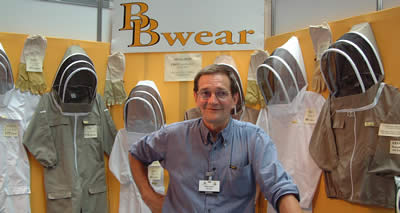

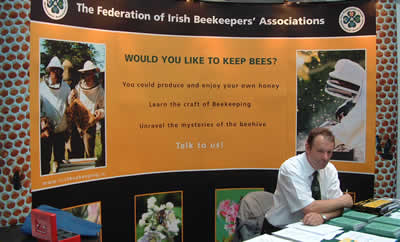

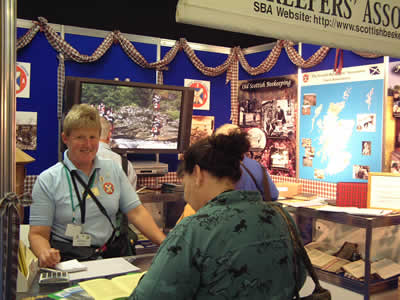
Above: The Scottish Beekeepers' Association stand
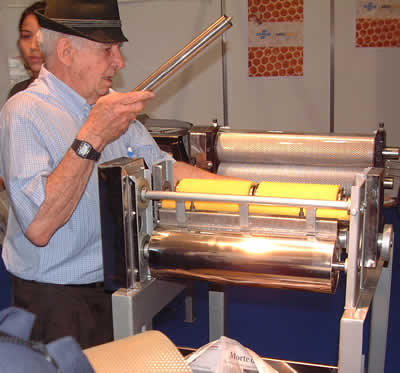
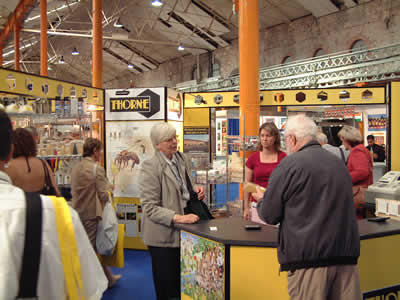
Below: No more lifting heavy supers during inspection of
the brood.
I might be worried
about having my head or fingers guillotined if the support wires failed!

All photographs by Steven Turner
Island Apes
Thank goodness for the small hive beetle. Now that we've got that varroa
mite under control we were running the risk of having nothing new to talk
about, speculate or worry over. Those experts in spin at DEFRA teased us with
that pyrethroid resistance rumour that sent us scurrying off to our suppliers,
but they have really out-done themselves with this new alarm; what a master
stroke: the 'deadly' small hive beetle, such weapons of mass destruction.
Branch meetings and publications would be devoid of new material if it were
not for this new potential threat. (Please remember that it is so much of
a risk that they are going to cut back on the funding of regional bee inspectors,
but here's a nice pamphlet on how to deal with it instead.) I once had the
scare-mongering procedure explained to me over lunch, by a DEFRA official
who had drunk too much and let a few things slip. 'Government departments
will generate a period of expectancy,' he told me, 'lasting anywhere from
6 months to 6 years, the prelude to the beetle's arrival for example. This
is followed by an alleged invasion and colonisation period lasting from 6
to 10 years.' During this period the drug companies will be urged to be seen
to be doing something and we'll be conned into buying their latest beetleicide
or coleopteracide which is just dilute vinegar in a fancy bottle. Then, in
the twilight of the beetle's notoriety, when everyone has realised that the
small hive beetle is nothing but a rather jumped-up, innocuous wax weevil,
they will reveal another threat: the Great Hive Beetle (GBH.) Oh Lord, there
will be mass panic. But at least (or maybe at most,) we will have something
new to talk about. Face it; we British thrive on worrying about what might
invade our island next. it's in our island-loving blood. What is just over
the horizon? They could strike us in 45 minutes. For this deep-seated neurosis
we can thank the Vikings. Constantly waiting for the church bells to ring:
the invasion has started, when we can rally around and look earnest. Whether
or not a threat really exists, who cares? A man told me that a man he knew
had a friend who was told by someone who knew a man that thinks that the small
hive beetle has arrived in Portugal.
We island apes, sitting on the beaches looking out to sea, worry constantly
if we might catch a glimpse of the oars of marauding long boats veiled in
mist, or small hive beetles, gathering in their thousands on the beaches of
France, making their last minute preparations before an attack. We will have
months, if not years of speculation and anticipation.
The propaganda machine is already in action. Like the local glazier who
found that the answer to his lack of custom lay in buying his son a catapult
for his birthday, there will be some that suspect DEFRA themselves of starting
these little rumours if not the outbreaks themselves! Maps will be produced
that will chart the beetle's blitzkrieg advance across southern Europe. Urgent
branch meetings will be held at five minute's notice to discuss the latest
advance by the enemy. Won't we just love it? They're coming, batten down the
hatches. There will be contingency plans: I will remove the road signs at
the end of my lane, becoming suspicious and informing the police if I see
newcomers at beekeeping meetings. I will sit next to the radio of an evening
waiting for Ian Homer to address the county. This is the BBC; today SHB has
been reported in Kent. And I will pat my wife's hand and say, 'everything
will be alright,' as she dries out the tealeaves to be used again before opening
the Spam(r). Think of all the things I will be able to make do with and mend.
John Chamberlain will be able to draw a water-saving line in his bath tub,
I will be able to draw a pencil line down the back of my legs, (no, I didn't
say that.) Bring back the extra sugar rations for we beekeepers. Bring it
on SHB, our island is ready! Crikey! The church bells are ringing... Chad
Cryer
RECIPE OF THE MONTH Back
to Top
Amalou (Morocco)
Something
novel for this month’s recipe; a spread to put on bread but
also delicious with toast.
Ingredients:
8 ounces Blanched white almonds, toasted.
4 fluid ounces oz walnut oil.
1/2 teaspoon Salt.
2 fluid ounces oz thick honey.
Directions:
In a blender, mix pulse the almonds with the walnut oil and salt.
When smooth, spoon in honey and blend for 30 seconds. Keep in an airtight container.
Simple, tasty and nutritious.
FACT
FILE Back
to top
Fact File Infant Botulism And Honey
This is a very contentious subject amongst beekeepers and health authorities.
Do our authorities over react? What do you think? Here are some facts relating
to infant botulism and honey and they arise from a query put at a local beekeepers
association meeting.
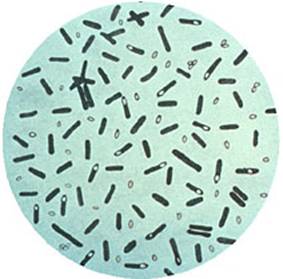
'Unsuitable for infants under 12 months." Almost
every jar of honey sold in the UK now comes with this warning, with no explanation
as to why and the Food Standards Agency strongly advises against giving honey
in any form to under-ones.
Why? Here are some facts of the matter.
It was in 1978 that honey became a forbidden food for infants. In 1976, a
very rare syndrome called infant botulism had been diagnosed for the first
time, after some babies in California were found to have traces of botulism
spores in their stools.
Two years later in 1978, an epidemiological study was done by the California
Department of Health Services. They tested more than 550 samples of food,
drugs and miscellaneous environmental substances for botulism. They found
botulism organisms in five samples of soil, one in dust from a vacuum cleaner
and nine of honey.
Don’t confuse the illness with adult botulism. Although
they are caused by the same Clostridium botulinum spores, the two illnesses
have widely differing effects. Food-borne adult botulism occurs when preformed
toxins enter the system in food. Hours after the contaminated food
is eaten, the patient will have difficulty with walking and swallowing. Their
muscles may become paralysed. In up to two-thirds of cases, patients will
die.
Infant botulism is much less extreme. The baby consumes botulism
spores which in themselves are not harmful, only becoming toxic
in immature intestines. (If an older child ate the same spores, they would
be fine). As many as 30 days after ingesting the botulism, he or she may
become constipated and listless, unable to suck as strongly or to cry as
loudly as usual - all the symptoms of “floppy infant syndrome”.
If taken to hospital in good time, the odds are strongly in favour of them
recovering. The mortality rate is about 1.3%.
Statistics show that botulism almost exclusively affects those under six
months, who, on current advice (at least in the US), shouldn’t be consuming
anything other than milk.
In the UK, there have only ever been six cases of infant botulism, none of
which implicated British honey. In the most recent case, in 2001, formula
milk was to blame.
HISTORICAL
NOTE Back to top
Most beekeepers have at one time or another been asked
to take a swarm and some will charge for this service (correctly
in my view) but as we can see from this month’s historical note,
charging for this skilled service is no new thing. This is an advert
placed by Robert Sydserff of Leigh on Mendip in his Treatise on
Bees written in 1792. If any of you are lucky enough not to recognise
the coinage used, ask at any beekeepers’ association meeting.
Like me, I suspect most will be familiar with it. Ed.
Advert
P.S. Any gentleman
whose bees have omitted swarming until the latter end of June,
and are desirous of increasing their stock, may have swarms
taken out of any old Hive, by Mr Sydserff, the author, which
shall do as well, or better, than those which come forth of
their own free choice. In like manner, Bees are taken out of
hollow trees, walls, or any other places on the following terms,
if not farther than four miles from his house.
For taking a swarm from an old Hive……………………….......5s
0d
Out of a hollow tree, or other place of danger……………….2s
6d
Taking the honey and comb without hurting the Bees……1s
6d
For taking a common swarm from a bush or tree…………..
1s 0d
POEM OF THE MONTH Back
to top
Most readers will now be aware of the talents of Emily Dickinson
who is often featured in Apis-UK. Here is another poem from
the pen of this delightful American poet.
A Bee his burnished Carriage
Emily Dickinson
A Bee his burnished Carriage
Drove boldly to a Rose—
Combinedly alighting—
Himself—his Carriage was—
The Rose received his visit
With frank tranquillity
Withholding not a Crescent
To his Cupidity—
Their Moment consummated—
Remained for him—to flee—
Remained for her—of rapture
But the humility.
LETTERS Back
to top
Dear David,
Just wanted to let you know about a brilliant book called 'Honey
and Dust' I've read recently. I'm a member of a Middlesex beekeeping
association and was recommended it by one of our members. It's
about a young man who goes around the world searching for ancient
beekeeping methods and wild honey hunting. A fantastic read. Horatio
Richards horatianode@yahoo.co.uk
Dear David,
You may be interested to know
that there is an article in Biologist, Vol 52, No 2 p88-94, May
2005, Enlisting fungi to protect the Honey Bee, by Lambert, Kanga,
Jones and James. It deals with the use of two fungi as biological
controls for the Varroa mite. Les
May
Hei!
Are you aware that the DNA illustration
in http://www.beedata.com/apis-uk/newsletters05/apis-uk0705.htm
is
mirror-imaged? That is the DNA is left-handed - alien bees? See:- http://www.lecb.ncifcrf.gov/~toms/LeftHanded.DNA.html greetings
from Norway Anthony N Morgan
Thanks for that. I told you genetics was a complex subject!
Ed.
Dear David,
Thank you so much for all commentaries, it is so
nice for me to have news from other counties about bees
and beekeeping. I'm a beekeeper from nord-vest of Romania and
I have 24 bee families. You do a great job Sir, God bless
you. With respect Liviu
Costea, Oradea, Romania.
Thanks for the comments Liviu and do keep in touch. Ed.
Dear David,
Another excellent edition of Apis - very good reading. Pam
Hunter
BEEKEEPING COURSES Back to top
Interested in Keeping Honey Bees?
We are the Bridgend and District Beekeepers Association.
We offer Beginners Classes, Advanced Classes*up to Master Beekeeper.
We are a friendly association which promotes beekeeping and supports beekeepers. Download
More Information [PDF 79KB] or visit www.bbka.co.uk Sue
Verran, Secretary, 01656 729699. verran@btinternet.com
Natural History of Pollination
Wednesdays
from 28 September 1.30 – 3.30pm for 12 sessions.
At Tulse Hill, South London. Gain a fresh understanding of the
diversity of flowers by exploring the different adaptations to
assist pollination. Examine fresh specimens and microscope slides,
and then explore more exotic structures in a visit to Kew Gardens.
Workers Education Association Study in 2005 at the South London
Botanical Institute 323 Norwood Road, London SE24 9AQ Tel. 020
8674 5787 Tutor – Dr June Chatfield. Download
the 2005 Programme [113KB PDF]
DATES
FOR YOUR DIARY Back
to top
Event
organisers are
welcome to forward
dates and details
of their events
to the editor (by
e-mail) for incorporation
on this page.
Friday 23rd to Sunday 25th September 2005 -
Midland and South Western Counties Convention and Conference.
It will be held on the edge of the Derbyshire Peak District at
the Hayes Conference Centre near Alfreton. It will be packed with
hot topics from shook swarming and small hive beetle to breeding
strategies to meet current challenges. We have an excellent list
of speakers which currently includes: Pat Mills, David Kemp, Norman
Carreck, Adam Hart, Graham Law, Bernard Diaper, Albert Knight,
Claire Waring, and Alistair Battersby. Full 2 1/2 day attendance
including all meals and overnight en suite accommodation will cost £180.
Day visitors will be welcome at £30 to £40 depending
on the day. A full programme and booking form can be obtained by
post from Peter Cash e-mail: peter @ cash42.freeserve.co.uk or in
pdf format from me email: steverose @ tiscali.co.uk. Everyone is
welcome; not just members of the 10 counties directly involved. Steve
Rose
24th & 25th September 2005 - West
Sussex BKA Honey Festival. The West
Sussex Honey Festival will be held on Sat/Sun 24-25th September
at Manor Nursery, Runcton, Chichester. This has now become an
annual event to publicise bees and honey, and this year the theme
is Bees in Your Garden. The venue is a well laid out garden centre
with a restaurant, and last year attracted around 1400 visitors
from far and wide. It has become a major beekeeping event. There
will be displays and demonstrations as well as 40 competitive
classes, many of which are innovative including a Black jar,
presentation gift pack, limerick, speciality honey, honey mustard,
art, and children’s classes. There will of course be the
usual traditional honey show classes. For those travelling some
distance there are other places to visit in the area including
The Weald and Downland Open Air Museum, Fishbourne Roman Palace,
and Uppark. For details log on to www.wsbka.bravehost.com and
click Honey Festival. For a schedule contact Graham Wells
01403 700317 or download from the website. For other details
contact Steve Kennett 01798 831 010 steve@profact.co.uk or Roger
Patterson 01403 790 637 r.patterson@pattersonpressings.co.uk
20th October 2005 - Central Association
of Beekeepers. Social
Evening (drinks and buffet) and Lecture at the Wax Chandlers’ Hall,
City of London. Speaker, Dr David Aston, Yorkshire. ‘Plants
and Honey Bees; their relationships’. For details and to
book contact Mrs MR English, 6 Oxford Road, Teddington, TW11 0PZ.
Tel: 020 8977 5867 http://www.cabk.org.uk/
Thursday, Friday, Saturday 20th-23rd October 2005 - The
2005 National Honey Show will be held at the Royal Air Force Museum,
Hendon, London, UK. Judging of more than 200 classes of
honey, beeswax, candles, mead, art-work, essays etc begins at 09.00
on Thursday 20th and the Show is open to the public from 14.00
until 18.45 that day. On Friday 21st it is open 09.30-18.45, and
on Saturday 09.30-16.50. Admission for members is free, but for
non-members it is £7.00 payable at the door. In addition
to the competitive classes, there is a full programme of lectures,
given by speakers of world renown, There are also many trade and
educational stands. For the latest news see our website: http://www.honeyshow.co.uk
11th-13th November 2005 - Central Association
of Beekeepers.
The Autumn Conference of the Central Association of Beekeepers
will be held in the Falcon Hotel, Stratford-upon-Avon. This is
a wonderful opportunity to meet other beekeepers in congenial surroundings,
with good food and hear a number of experts talk on a wide range
of topics. The talks confirmed to date are: Biological Control
of the varroa mite with pathogenic fungi, by Dr David Chandler,
Warwick Horticultural Research International. Spatial Modelling
of bumble bee populations by Dr Judith Osborne, Rothamstead. For
details and to book contact Mrs MR English, 6 Oxford Road, Teddington,
TW11 0PZ. Tel: 020 8977 5867 or E-mail norman.carreck@bbsrc.ac.uk
http://www.cabk.org.uk/
Sunday 13th November 2005 - Integrated Varroa Management
Workshop. Hosted
by Melksham & District Beekeepers Association at Cooper-Avon
Sports & Social Club, Melksham House, Market Place, Melksham,
Wiltshire. Entrance Ticket £6.00. For more details Download
Leaflet and Download
Programme (Both PDF
files which need Acrobat Reader 4+ to open).
13th - 18th November 2005 - International
Beekeeping Congress 2005 India. Le Meridien
Bangalore, India (Organized by: Century Foundation, Bangalore). On
behalf of the Organizing committee of the International Beekeeping
Congress, it is our privilege and honour to extend a warm invitation
to you to participate in the deliberations of the scheduled congress
to be held from November 13-18, 2005. The main aim of the congress
is to bring together the beekeepers, honey traders and International
Scientific Community involved in research and development of beekeeping
for sustainable livelihoods and rural development. The proposed congress
will disseminate advanced information on beekeeping for further improvement.
Bangalore is a beautiful city, the capital of Karnataka in India. Karnataka
has unique flora and fauna including important honeybee species.
This congress will be an opportunity for the delegates to visit various
biodiversity hotspots in the country. We are sure; the congress will
present a unique opportunity to share the recent trends in beekeeping
and development. Also, you can enjoy the wonderful hospitality of
Indian people. The local organizing committee and Century Foundation
will try their best to make your stay comfortable and enjoyable during the
congress. We are looking forward to meeting you during the Congress.
Organizing Secretary Chairperson – Scientific Committee Dr.
V. Sivaram Email: info@cenfound.org Web: www.cenfound.org/IBC-2005/indexpage.html
Saturday 26 November 3pm -
Kent Education Group Guest Lecture Celia Davis: Mr Bee.
To be held at Langton Lecture Theatre, West Kent College, Brook
Street, Tonbridge.
Celia Davis is the widely-respected author of ‘The
Honey Bee Inside Out’ - a lively, detailed account of the anatomy
and physiology of the honey bee presented in a clear and concise
format. She has a degree in agriculture and has been ‘fascinated
by insects’ since childhood. She has kept bees for over 20
years and gained her NDB in 1996 having previously won the Robert
Hammond Award and the Wax Chandlers Prize. She spent six years on
the BBKA Examinations Board, is a correspondence tutor and continues
to lecture on beekeeping, insects and environmental aspects to a
wide range of groups. Her talk to Kent beekeepers promises to be
one of great interest. Mr Bee - This talk attempts to change the
average beekeeper’s
view of drones as useless, expendable members of the bee community.
It will cover all aspects of the drone’s life and its importance
to the colony. Drawing on her experience in beekeeping and her wide
knowledge of the insect world Celia will relate the structure of
the drone to its function, stressing how perfectly adapted the drone
is to its role. She will also discuss aspects of the relationship
between the life cycles of drones and Varroa.
The lecture starts at 3pm and there will be refreshments, a stand
from Northern Bee Books and more. Doors open at 2pm. There are excellent
parking facilities at the college, good links to the motorway and
it is only a 10 minute walk to the mainline station and the town
centre. The venue has disabled access. Tickets £3.00 available
in advance and further information from Terry Hardy telephone 01622
832066 or email theresa.hardy@virgin.net Terry Hardy (Kent BKA)
6 Springrove Cottages, Goudhurst Road, Marden, Kent, TN12 9JU. Download
Celia Davis Lecture Leaflet PDF
20th - 24th March 2006 - Eighth Asian Australian
Apicultural Conference 2006 Perth. Western Australia. For all information please visit
the website http://www.beekeepingwestaus.asn.au or
contact: Debrett's Conference & Event Management PO Box 441,
Nedlands, WESTERN AUSTRALIA 6909 Telephone: +61 (08) 9386 3282 Email:
honeybee@debretts.com.au
Editor: David Cramp Submissions
contact the Editor
Web Editor: Steven Turner
E-mail addresses
are not hyper linked to prevent harvesting for spamming
purposes. We recommend you cut & paste
to your e-mail client if required.
QUOTE OF THE MONTH Back
to top
Quote last month
Last month’s quote was from a more obscure writer
except in his native land. It was from Luis Vigil, from his ‘Pensamientos
y observaciones’ or thoughts and observations.
Quote of this month
This month’s quote comes from a well known person and
like last month’s it talks of life in general.
“To carry a grudge is like being stung to death by one bee”.
Click
here to print this page
|